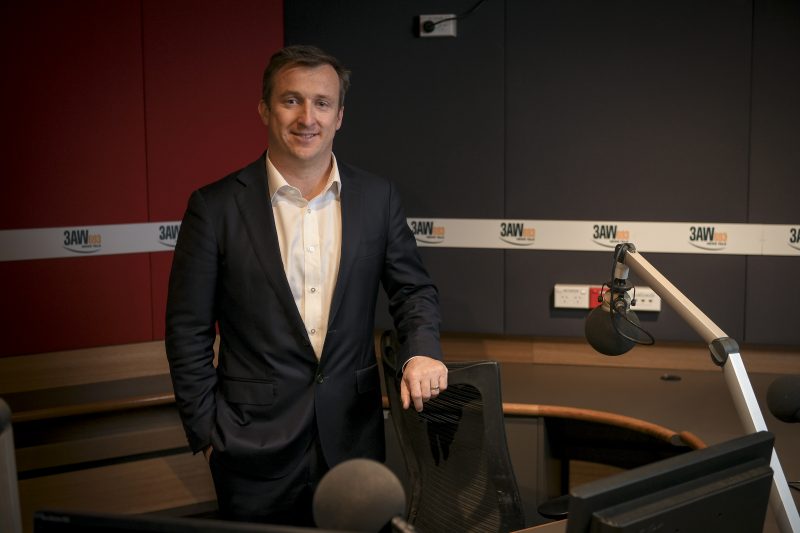Nine Radio’s Tom Malone on Alan Jones, the importance of localism and the 2020 content lineup
Since Nine took ownership of Macquarie Media in 2019 there’s been a raft of changes pushed out across the media business. Mumbrella’s Hannah Blackiston spoke with managing director Tom Malone to find out why these changes were necessary and whether there are more to come.
He’s only had his feet under the desk for a couple of months, but Nine’s newly-appointed managing director of its radio assets, Tom Malone, is very confident in what makes 2GB, 3AW, 4BC and 6PR great.
“You always need to listen to your audience and we do that better than anyone, that’s why people like Alan Jones and Ross and John have been number one for thirty years, because we’re very good at listening to our audience. We’ll always listen to them,” Malone told Mumbrella.

Tom Malone at 3AW studio in Docklands. 6 November 2009. The Age News. Photo: Eddie Jim.


As a regular listener to 2GB, I find the station has lost its way.
Lossing Steve Price was a big mistake. Deb Knight is a sweet person but lacks emotion and passion, she is too nice.
Bring back backbone to the station, with people who have compassion and not afraid to speak the truth. Though it might not be political correct.
2 GB is boring now.
Why have you destroyed a successful programme like George and Paul bringing back Chris Smith. He is narccisistic. Jobs for the boys and his partener. Last weekend I changed channels, the first time in many years and I won’t be returning while he is there.
Regards
Carol Roberts
Alan Jones is ny number one, always listen to Alan he is Great very knowledgeable and bright.
Welcome back to Chris Smith he put a very entertaining program.
HOP[E NUINE RADIO SIGNS DYLAN BUCKLEY TO 3AW TO REPLACE JOHN BURNS JHE DOES A SEGMENTON 3AW DRUVE TEACHUBG 3AW’ LISTENERSHIP ABUT WHNATY HAPPENS IN HIS GEBNERATION.
I Heart Jason Andrew Toppin Comments
2GB has lost the plot. The return of Alan Jones cannot come sooner.
After Jones’ show the station goes down hill. Ray Hadley is overrated and arrogant. Deb Knight is fluffy and light weight. Ben Fordham is VERY light weight. The night show is too bad to be true. Stanley’s replacement during the Summer was outstanding and should replace Stanley full time.
I don’t like being critical but the station is going down the drain. I cannot imagine where it will end up after Jones retires.
Ernst
Alan Jones listens to his audience as long as they agree with him and he basically doesn’t let you on if isn’t something he likes or he just talks over them
Also when is he going to stop bullshiting that he’s audience is a couple of million
I’ve been trying to find out about the soft launch time on February 2 At 2UE but can’t seem to get any information from Nine Entertainment. Does anybody know, thanks.
“We’ve identified a gap in the market, which is the best of the 70s, 80s and 90s”
“Fleetwood, Blondie, Chisel, Elton, ABBA, Robbie, Morrison, INXS, Roxette…”
……Does this bloke actually listen to the radio? Is this meant to be a unique playlist that I’m going to switch stations for?
I don’t work in this industry, so can someone please explain why all these radio executives seem to think the best way to innovate.. is just to rehash the same tired concepts and generic playlists over and over?
Why don’t they ever have the guts to try something truly different?
I will stick with Alan Jones look Ray Hadley is so hit and miss and should be open to other people’s opinions sometimes he might as well talk to himself in other words Loosen Up
As for the others well time will tell as I listen to your station my views are echoed by my friends
Regards. Rob
Gee.Those people who are saying that 2GB has lost it’s way…you have not been listening to 2UE in recent years!!!!
Lets hope Nine can steady the ship as far as 2UE is concerned.
Bringing back the iconic name is one thing ,a good thing but if the market sees it as a poor imitation of the “original and authentic” 2UE then forget it.Some of the old jingles and the like would be good rather than a bland network approach.
The ratings will jump but for how long will be the big question!
Nine radio will have a good year. 2UE, 4BH, Magic will do far better in the ratings that Macquarie Sports Radio and will provide a higher revenue stream and be a strong competitor to Smooth & WS/Gold/4KQ. In the future, Nine radio could roll out even more national (Syd, Mel, Bris, Per) music formats to monetise more of their digital radio spectrum.